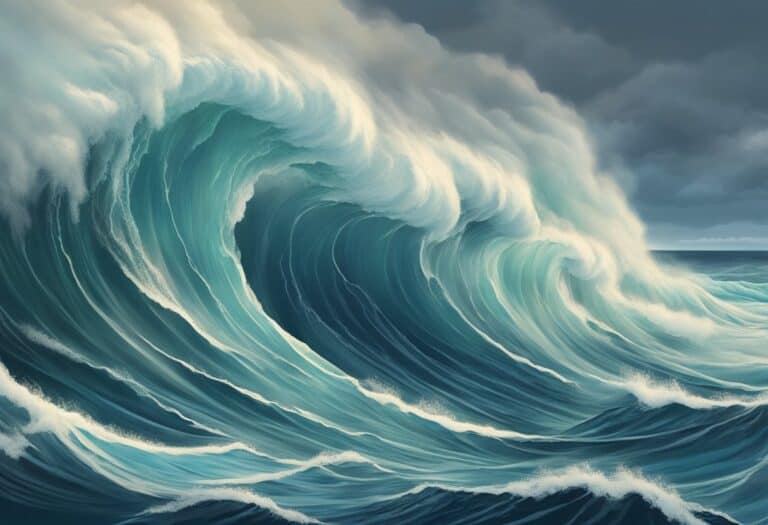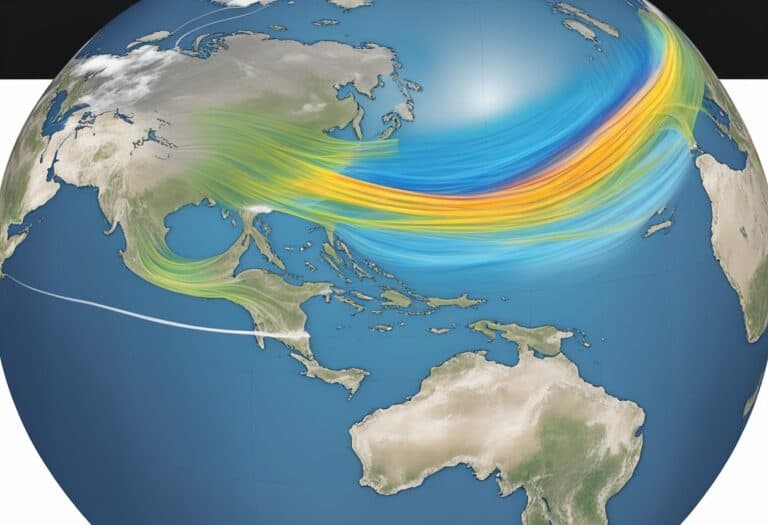Surfing is a sport deeply connected to the whims of nature, with weather elements playing a crucial role in shaping the experience.
As a surfer, understanding how different weather variables affect surf conditions can enhance your time in the water. Elements such as wind direction, speed, and atmosphere pressure can drastically alter wave quality. While the wind can groom or destroy the surf, atmospheric pressure systems are responsible for generating the swells that surfers crave.
Additionally, factors like temperature, tides, and daylight hours are all part of the intricate dance between the ocean and the atmosphere, influencing when and where waves may be at their best for surfing. Seasonal weather patterns also dictate the surfing conditions, varying from region to region.
As such, knowledge of local climatic idiosyncrasies becomes just as important as mastering the art of catching waves. Being able to predict the best surfing conditions is a valuable skill, helping you to maximize your time riding the waves, and minimize the days spent waiting for suitable weather.
Sea whispers in wind and swell, a symphony for surfers bold. Offshore winds sculpt glassy rides, onshore chaos takes hold. Pressure whispers giants deep, sun paints fleeting shores. Each tide a shifting stage, where knowledge lights the roars. Decode the ocean’s song, a dance of elements true.
Weather Fundamentals for Surfing
Before venturing into the surf, it’s crucial you understand how weather patterns play a decisive role in wave formation and conditions. Knowledge of oceanography and meteorology is not just useful; it’s essential for every surfer.
Understanding Oceanography and Meteorology
Oceanography and meteorology are central sciences that inform surfing. Oceanography encompasses the physical and biological characteristics of the ocean, providing you with insight into how currents, tides, and seabed topography shape the waves you ride. Meteorology, on the other hand, equips you with the knowledge of atmospheric conditions—the science behind the weather forecasts that can make or break your surfing plans. It’s the study of wind patterns, climatology, and their influence on day-to-day surf conditions.
Together, these fields form the bedrock of your understanding of the surfing environment. For surfers, grasping these concepts is not purely academic; it directly impacts your ability to read waves and anticipate good surf days.
The Role of Wind and Atmospheric Pressure
-
Wind: Wind direction and speed are pivotal in wave creation. Offshore winds (blowing from the land to the ocean) can sculpt waves into cleaner, more surfable forms, while onshore winds (moving from the sea toward land) often result in choppy, disordered surf.
-
Atmospheric Pressure: Changes in atmospheric pressure can signify incoming storm systems or weather changes. Lower pressures often precede unsettled weather and can generate larger, more powerful swells. In contrast, stable, high-pressure systems tend to bring calmer seas and smaller waves. Understanding how atmospheric pressure influences surf can inform your decision on when to paddle out.
Being attuned to these elements will refine your ability to forecast surfing conditions. By applying knowledge from atmospheric science to interpret forecasts accurately, you’re better prepared to find ideal surf conditions.
Predictive Elements for Surfing Conditions
When planning your surf session, understanding how to predict surfing conditions is crucial. Weather forecasts, wave characteristics, and wind directions play pivotal roles in shaping the opportunities for an ideal surfing experience.
Interpreting Weather Forecasts
Weather forecasts are indispensable for surfers. You’ll want to pay attention to tropical weather systems and weather fronts, as they significantly impact wave activity. Cold fronts often lead to larger waves, while warm fronts may result in milder conditions. The movement of low-pressure systems can indicate the potential for stormy weather, which might generate powerful swells but also pose safety risks. Surfline and similar services provide detailed forecasts that include wave height and wind direction, helping you to devise your surf strategy effectively.
Recognizing Optimal Wave Conditions
Identifying optimal wave conditions entails understanding several key elements:
- Wave Height: It often correlates with the excitement level of your session; however, the ‘perfect’ height is subjective and depends on your skill level and preferences.
- Swells: Generated by distant weather systems, they are the energy underneath the ocean’s surface that eventually breaks into waves. The size and direction of the swell are major indicators of the conditions you should anticipate.
- Fetch: This is the area of ocean surface over which the wind blows to generate waves, and a long fetch usually means better-formed waves.
- Break: Waves can break differently depending on the sea floor contours and fetch, affecting whether you face plunging, spilling, or surging waves.
Wind direction also affects the surf conditions; offshore winds can create cleaner, more precise breaks, while onshore winds might lead to choppier, less predictable waves. Incorporate these factors into your surf strategy for a successful outing.
Regional Surfing Considerations

When you consider surfing locales globally, it’s essential to understand how regional climate variations and specific weather patterns can impact surfing conditions.
Surfing and Climate Variance by Location
Australia: As a surfing powerhouse, Australia boasts a wide range of surfing spots influenced by the Southern Ocean’s swells. Seasons play a crucial role here, with winter offering consistent waves for locations like Bells Beach and summer favoring northern spots, gold-coated by favorable wind patterns.
California: Home to the iconic surf culture, California’s surfing conditions are shaped by Pacific storms. Northern spots like Mavericks come to life during winter months, with waves amplified by storm activity, while Southern California enjoys milder conditions that are better suited for beginners.
Hawaii: Hawaii, birthplace of modern surfing, is affected by multiple weather systems, predominantly in winter when the North Pacific delivers world-class waves to the North Shore of Oahu, suiting professional surfers heading to Pipeline or Waimea Bay.
Tahiti: Known for the infamous Teahupo’o, Tahiti’s tropical climate leads to massive swells generated by distant storms. This island relies on the consistency of these systems to provide the power behind its legendary waves.
Olympic Surfing: The inclusion of surfing in the Olympics, showcased in Tokyo 2020, underscored the necessity for seasonal understanding. Olympic surfing locations, if continued in diverse regions, must consider the best season for optimal wave generation.
Tropical Weather Systems: Areas like North Carolina or those in the path of typhoons or hurricanes can see a surge in wave activity. Be mindful that while such conditions can create excellent surfing opportunities, they also carry inherent risks and the necessity for safety measures.
South Africa: Amidst security concerns, South Africa’s Jeffreys Bay has become synonymous with high-quality surfing conditions, where Indian Ocean swells create surf-friendly waves year-round, with a peak season from June to August.
United States: Beyond California, other regions in the United States host surfing spots affected by local climate patterns, such as the hurricane swells that impact the East Coast, offering a different appeal compared to the famed West Coast waves.
Your understanding of these regional surfing factors will help you select the optimal destination and time for your surfing experience, whether you’re looking to witness a world-class location come alive or seeking a beginner-friendly beach break.
Practical Aspects of Surfing in Diverse Conditions
When you engage with the ocean’s waves as a surfer, understanding and adapting to various weather conditions is crucial for both performance and safety. Mastering different conditions requires specific techniques, while adhering to surf etiquette ensures a respectful and secure environment for all water enthusiasts.
Adaptation Techniques for Surfers
To excel in diverse surfing conditions, you must be adept at reading meteorological data, which includes understanding how various factors such as rain, temperature, and storm patterns affect the ocean. Onshore winds can create chop, making the surf rough and difficult to navigate, whereas offshore winds can make waves cleaner and more suitable for surfing.
Tidal movement also plays a major role in how waves break on different bottom contours. For instance, beach breaks with shifting sandbars may produce inconsistent waves, whereas reefs and point breaks offer more predictable, quality waves. Aspiring wave chasers and surf school students should practice in varied conditions to become versatile surfers.
- Surfing Strategy: Be mindful of local tidal movement and bottom contours to anticipate wave behavior.
- Surfboard Selection: Choose a board that matches the day’s conditions; a larger board for small, mediocre waves or a shorter board for larger waves when seeking competitive surfing glory.
Safety Measures and Surf Etiquette
Your safety and the well-being of others should always come first. It’s important to understand and respect surf etiquette, whether you’re practicing for surf competitions such as those held at Tsurigasaki Beach or simply enjoying a casual session.
- Weather Conditions Awareness: Keep track of the forecast provided by the lead forecaster. Sudden changes can lead to dangerous situations, like rip currents or lightning during a storm.
- Know Your Limits: Don’t paddle out in conditions beyond your skill level. The International Surfing Association promotes safety by advising surfers to surf within their capabilities.
Safety equipment, including a leash and possibly a helmet in rough conditions, is essential. Moreover, staying aware of your surroundings, and being considerate of fellow surfers by not dropping in on their waves, ensures a positive experience for everyone in the lineup.
- Stay Visible: Wear bright colors to increase your visibility, especially during poor weather conditions like rain or low sunshine.
- Communication: Use hand signals or shouts to communicate with others, particularly in noisy or turbulent conditions.
Frequently Asked Questions
In this section, you’ll discover how various weather conditions and oceanic patterns affect your surfing experience, helping you to make informed decisions before heading to the surf spot.
What determines the quality of surf conditions?
The quality of surf conditions is influenced by a combination of factors, including wave height, swell direction, tide levels, and wind conditions. These elements work together to create the ideal wave shape and power for surfing.
How does swell direction impact a surfer’s experience?
Swell direction determines the angle at which waves approach the beach and can significantly affect the break of a wave. The ideal swell direction varies depending on the surf spot’s topography and can make the difference between a good and a bad surf session.
Can you explain storm surge and its effect on surfing?
Storm surge is an abnormal rise in sea level during a storm, caused by strong winds pushing water towards the shore. This can lead to more powerful and higher waves, which might be appealing to experienced surfers but can also increase the risk of dangerous conditions.
What characteristics make up an ideal swell for surfing?
An ideal swell for surfing is characterized by long wave periods, a consistent direction, and adequate wave height. These factors contribute to the formation of clean, well-spaced waves suitable for both maneuvers and long rides.
What should beginners look for in surf forecast conditions?
Beginners should look for smaller, more manageable waves with gentle wind conditions. A favorable tide and the absence of strong currents are also important for a safe and enjoyable entry-level surfing experience.
How does wind direction and speed influence surf waves?
Wind direction and speed can either enhance or degrade surfing conditions. Offshore winds (blowing from land out to sea) help to form cleaner, more hollow waves, while onshore winds (blowing from sea to land) can make waves choppy and disorganized. The right balance of wind strength can create ideal surf waves, whereas too strong winds can be detrimental.







